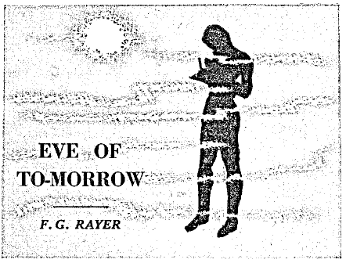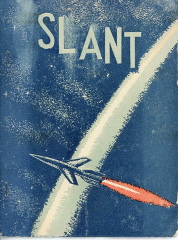

This story formed the core of Undying Enemy, published in Science Fantasy No 3, at the end of 1951.

Illustration: James White.
Steel shod boots scuffed rhythmically through the peppery hills, leaving a winding trail in the saffron dust. Eyes stared ahead at the yellow plain, unmarked by movement or artifice of men, or turned sometimes to look back, following for a moment the long trail which snaked across the slopes, up a valley, and from sight where the ochreous horizon met the sky. Away to the left stood, pole-like and corky, the remnants of once living woodland. An ear, delicate and shell-like as the painting of an old master, turned towards it, but no birds sang in the dead trees. No creature stirred under them, or man or machine moved among the brittle, fossilised trunks.
The feet went on, and the sun cast ahead the shadow of a beautiful woman, fine of face, firm and graceful of muscle and limb. She altered her direction slightly, and soon her shadow fell across the torn roofs of empty buildiugs buried up to the eaves in the drifting brown particles. She paused, as if wondering what past knowledge of men lay buried here, hidden for ever as the sterile earth drifted like sand into the great libraries of the world, then went on. A light wind moaned over the undulated brown, raising tiny eddies of brown particles like wisps of smoke, and she began to hurry. Since growing things had relapsed their tenure upon the earth fearful dust-clouds often raced upon the screaming wind, so that a dark twilight came at mid-day and the sun was hidden. The poisoned, dusty soil rose many miles into the air, sweeping fantastically across whole continents. Rivers ran brown and no fin stirred in their polluted depths, or in the seas, tainted with the same noxious death.
Her footsteps came to a stream, and she halted. No plants grew upon its barren banks and the swirling brown water held no life. She followed its course, going down upon the plain, eyes searching always for something that lived.
Farther on, a town lay empty, the wind-driven sterile soil only up to its second floor windows. She went through the tall buildings, upthrust through the dust like the relics of some ancient city, listening always, her eyes never still. Beyond a great building the curling wind had drawn away the all-pervading dust; the bonnet of an automobile showed, and scattered bones, burning brightly in the sun. A newspaper flapped, uncovered by odd chance, yellowed and crinkly. "The decision to use poisonous radio-active dust must never be lightly taken . . ." a partly visible paragraph in big type said. She bent, touching the sheet lightly with gloved lingers, but it crumbled like a dry, fragile leaf into nothing.
She went on, her face expressing nothing, until she had passed through he unpeoplcd city. Soon night would come, and she stopped, taking from her back a satchel made of thin chain-mail and lifting out a book of thin steel pages. With a pointed instrument which left an ineraseable blue line upon the steel, she wrote: "This is the thousandth evening since I was sent out by my master to search. I have found no living thing. In five more days I shall return to my master."
The sun sank; a brilliant moon shone across the dusty hills, leaving cear-cut, inky shadows, and she went on. Once a sharp clear crack came echoing through the night and she turned towards it, walking until she found herself among the sticks of a dead forest. Another bough broke, scattering a thin mist of fine earthy particles, and she turned away, her face expressionless ....
The sun shone brightly as she approached her home, a steel dome upon high rocks. Blown earth lay piled against one side, but the steps were half clean and she mounted slowly, her shod feet loud upon the naked rock. The dome had windows, and a sliding door. Now it stood slightly open, and a trickle of dust lay in the crack in which it rolled. She went in, looking each way, then stopped. Bones, white in the dimness, lay near a couch. An eddying wind had swept dust upon them, and upon all the objects in the room.
For a long time she stood motionless, gazing upon the bones, and listening to the sigh of the wind, now rising. Soon the poisoned, dusty soil would race upon the wind, darkening the sun and silting into obscurity great buildings where lay the whole knowledge and history of mankind, unread for fifty years.
As if at a loss, is if having no activity pattern to respond to this, the unexpected, she stepped backwards quickly. One steel heel caught in the groove in which the door slid, and she fell backwards, jarring down the rocky steps. There, her head split like a compressed tin-can; tiny wheels and electronic tubes sprang through the opening and lay on the dust. One foot twitched, then she was still, her machinery silent, the mechanisms of her cogitation halted. `
The rising wind swept long trails of dust across the peppery hills; a pole-like tree snapped, but no eye saw it fall, and no ear heard it, or the piping gusts carrying the saffron dust high in the obscured sky ....
Francis G. Rayer.